2022 TOYOTA COROLLA drive belt
[x] Cancel search: drive beltPage 20 of 678

18Pictorial index
■Interior (left-hand drive vehicles)
SRS airbags ......................................................................................P.35
Floor mats.........................................................................................P.28
Front seats......................................................................................P.126
Head restraints ...............................................................................P.128
Seat belts ..........................................................................................P.31
Console box ...................................................................................P.398
Inside lock buttons ........................................................................ P.116
Cup holders ....................................................................................P.397
Rear seats .......................................................................................P.127
Rear seat heater switches*............................................................P.392
*: If equipped
Page 26 of 678
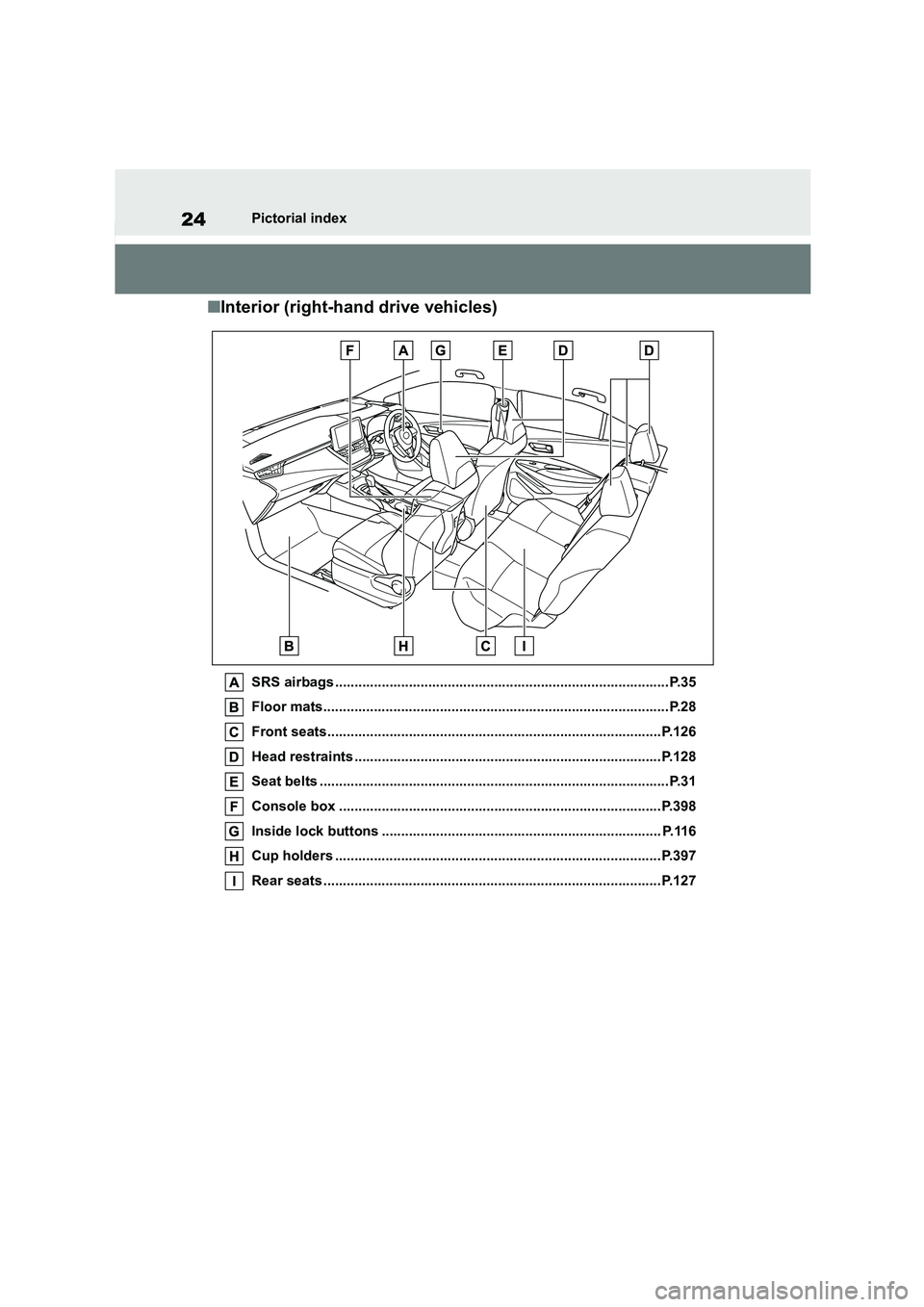
24Pictorial index
■Interior (right-hand drive vehicles)
SRS airbags ......................................................................................P.35
Floor mats.........................................................................................P.28
Front seats......................................................................................P.126
Head restraints ...............................................................................P.128
Seat belts ..........................................................................................P.31
Console box ...................................................................................P.398
Inside lock buttons ........................................................................ P.116
Cup holders ....................................................................................P.397
Rear seats .......................................................................................P.127
Page 31 of 678
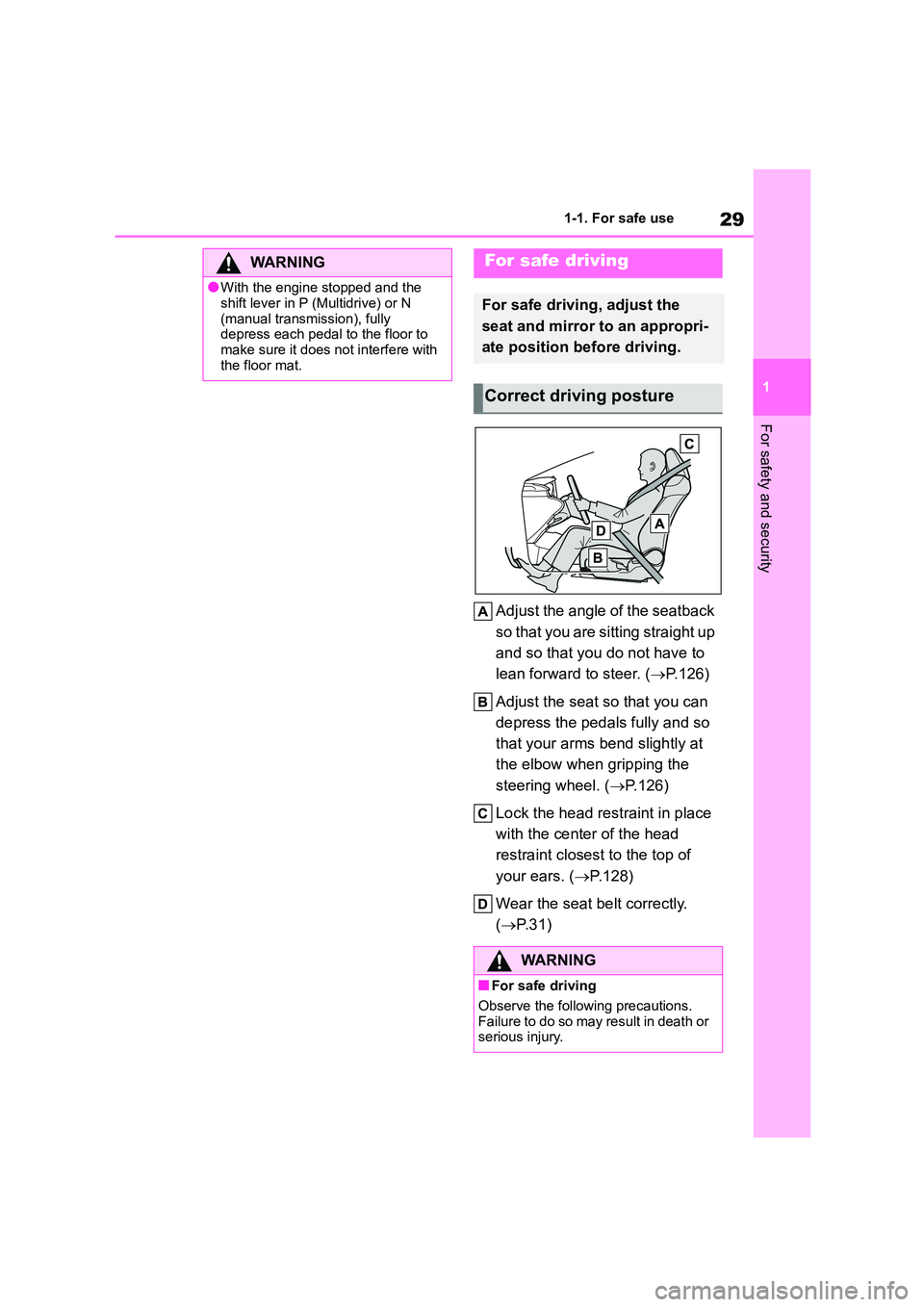
29
1
1-1. For safe use
For safety and security
Adjust the angle of the seatback
so that you are sitting straight up
and so that you do not have to
lean forward to steer. ( P.126)
Adjust the seat so that you can
depress the pedals fully and so
that your arms bend slightly at
the elbow when gripping the
steering wheel. ( P.126)
Lock the head restraint in place
with the center of the head
restraint closest to the top of
your ears. ( P. 1 2 8 )
Wear the seat belt correctly.
( P. 3 1 )
WA R N I N G
●With the engine stopped and the
shift lever in P (Multidrive) or N
(manual transmission), fully depress each pedal to the floor to
make sure it does not interfere with
the floor mat.
For safe driving
For safe driving, adjust the
seat and mirror to an appropri-
ate position before driving.
Correct driving posture
WA R N I N G
■For safe driving
Observe the following precautions.
Failure to do so may result in death or serious injury.
Page 32 of 678
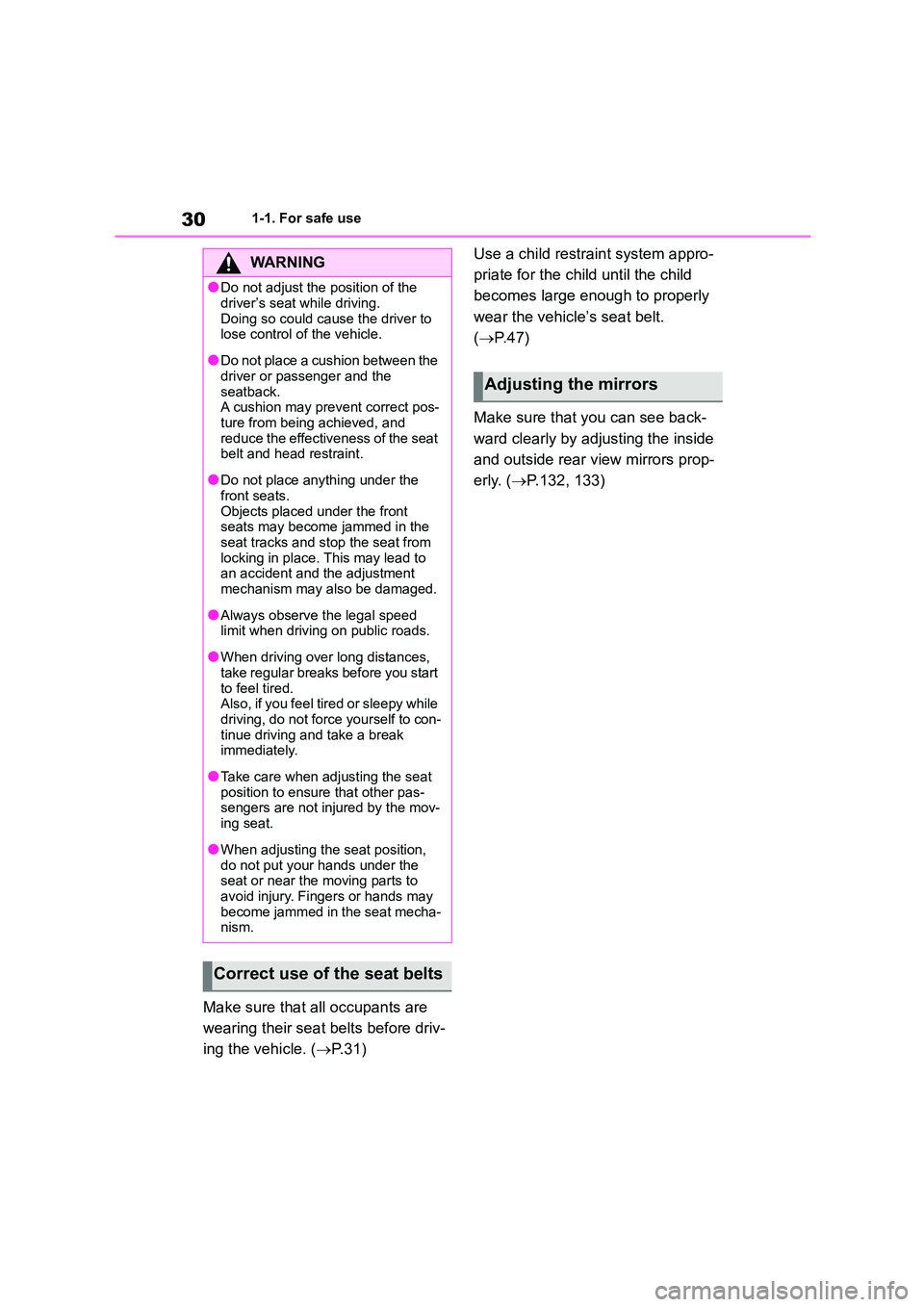
301-1. For safe use
Make sure that all occupants are
wearing their seat belts before driv-
ing the vehicle. ( P. 3 1 )
Use a child restraint system appro-
priate for the child until the child
becomes large enough to properly
wear the vehicle’s seat belt.
( P. 4 7 )
Make sure that you can see back-
ward clearly by adjusting the inside
and outside rear view mirrors prop-
erly. ( P.132, 133)
WA R N I N G
●Do not adjust the position of the
driver’s seat while driving.
Doing so could cause the driver to lose control of the vehicle.
●Do not place a cushion between the driver or passenger and the
seatback.
A cushion may prevent correct pos-
ture from being achieved, and reduce the effectiveness of the seat
belt and head restraint.
●Do not place anything under the
front seats.
Objects placed under the front seats may become jammed in the
seat tracks and stop the seat from
locking in place. This may lead to an accident and the adjustment
mechanism may also be damaged.
●Always observe the legal speed
limit when driving on public roads.
●When driving over long distances,
take regular breaks before you start
to feel tired. Also, if you feel tired or sleepy while
driving, do not force yourself to con-
tinue driving and take a break immediately.
●Take care when adjusting the seat position to ensure that other pas-
sengers are not injured by the mov-
ing seat.
●When adjusting the seat position,
do not put your hands under the seat or near the moving parts to
avoid injury. Fingers or hands may
become jammed in the seat mecha- nism.
Correct use of the seat belts
Adjusting the mirrors
Page 37 of 678
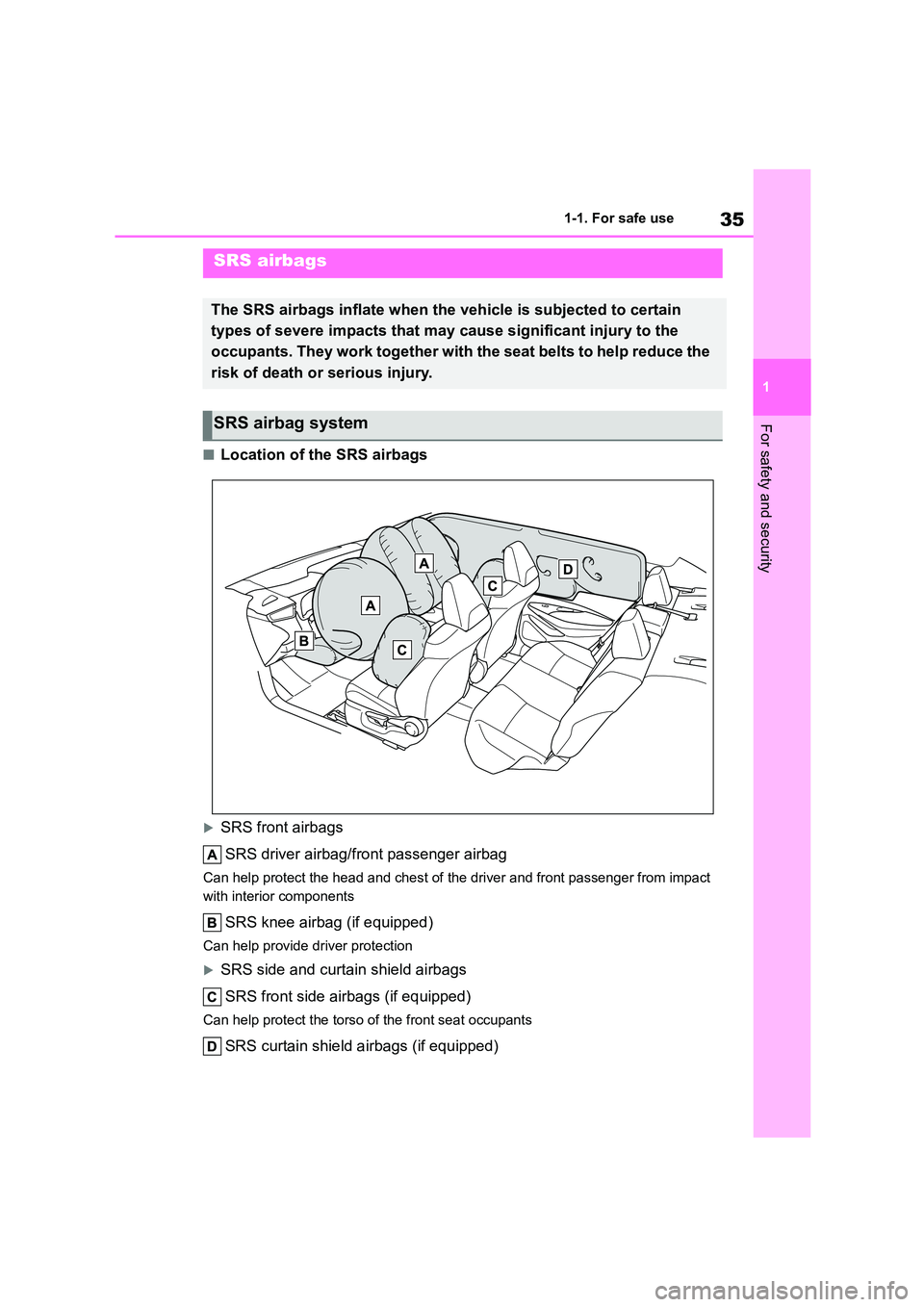
35
1
1-1. For safe use
For safety and security
■Location of the SRS airbags
SRS front airbags
SRS driver airbag/front passenger airbag
Can help protect the head and chest of th e driver and front passenger from impact
with interior components
SRS knee airbag (if equipped)
Can help provide driver protection
SRS side and curtain shield airbags
SRS front side airbags (if equipped)
Can help protect the torso of the front seat occupants
SRS curtain shield airbags (if equipped)
SRS airbags
The SRS airbags inflate when the vehicle is subjected to certain
types of severe impacts that may cause significant injury to the
occupants. They work together with the seat belts to help reduce the
risk of death or serious injury.
SRS airbag system
Page 38 of 678

361-1. For safe use
Can help protect primarily the head of occupants in the outer seats
■SRS airbag system components
Seat belt pretensioners and force limiters (if equipped)
Side impact sensors (front) (if equipped)
Airbag manual on-off switch
Front passenger airbag
Side airbags (if equipped)
Curtain shield airbags (if equipped)
Side impact sensors (rear) (if equipped)
SRS warning light
Side impact sensors (front door) (if equipped)
Driver airbag
Driver’s knee airbag (if equipped)
“AIR BAG ON” and “AIR BAG OFF” indicator lights
Front impact sensors
Airbag sensor assembly
The main SRS airbag system components are shown above. The SRS
airbag system is controlled by the airbag sensor assembly. As the airbags
deploy, a chemical reaction in the inflators quickly fills the airbags with
non-toxic gas to help restrain the motion of the occupants.
■If the SRS airbags deploy (inflate)●Slight abrasions, burns, bruising etc.,
Page 39 of 678

37
1
1-1. For safe use
For safety and security
may be sustained from SRS airbags,
due to the extremely high speed deployment (inflation) by hot gases.
●A loud noise and white powder will be emitted.
●Parts of the airbag module (steering wheel hub, airbag cover and inflator)
as well as the front seats, parts of the
front and rear pillars, and roof side rails, may be hot for several minutes.
The airbag itself may also be hot.
●The windshield may crack.
●The brakes and stop lights will be con- trolled automatically. ( P.316)
●The interior lights will turn on automat- ically. ( P.395)
●The emergency flashers will turned on automatically. ( P.462)
●Fuel supply to the engine will be stopped. ( P.470)
●Vehicles with eCall: If any of the fol-
lowing situations occur, the system is
designed to send an emergency call*
to the eCall control center, notifying
them of the vehicle’s location (without needing to push the “SOS” button)
and an agent will attempt to speak
with the occupants to ascertain the level of emergency and assistance
required. If the occupants are unable
to communicate, the agent automati- cally treats the call as an emergency
and helps to dispatch the necessary
emergency services. ( P. 6 4 ) • An SRS airbag is deployed.
• A seat belt pretensioner is activated.
• The vehicle is involved in a severe rear-end collision.*: In some cases, the call cannot be
made. ( P. 6 5 )
■SRS airbag deployment conditions (SRS front airbags)
●The SRS front airbags will deploy in the event of an impact that exceeds
the set threshold le vel (the level of
force corresponding to an approxi- mately 20 - 30 km/h [12 - 18 mph]
frontal collision with a fixed wall that
does not move or deform).
However, this threshold velocity will be
considerably higher in the following situ-
ations: • If the vehicle strikes an object, such
as a parked vehicle or sign pole,
which can move or deform on impact • If the vehicle is involved in an
underride collision, such as a collision
in which the front of the vehicle “underrides”, or goes under, the bed
of a truck
●Depending on the type of collision, it is
possible that only the seat belt
pretensioners will activate.
■SRS airbag deployment conditions (SRS side and curtain shield
airbags [if equipped])
●The SRS side and curtain shield
airbags will deploy in the event of an
impact that exceeds the set threshold level (the level of force corresponding
to the impact force produced by an
approximately 1500 kg [3300 lb.] vehi- cle colliding with the vehicle cabin
from a direction perpendicular to the
vehicle orientation at an approximate speed of 20 - 30 km/h [12 - 18 mph]).
●Vehicles with an SRS driver’s knee airbag: Both SRS curtain shield
airbags may deploy in the event of a
severe side collision.
●Both SRS curtain shield airbags may
also deploy in the event of a severe frontal collision.
■Conditions under which the SRS
airbags may deploy (inflate), other
than a collision
The SRS front airbags and SRS side
and curtain shield airbags may also
deploy if a serious impact occurs to the
underside of your vehicle. Some exam- ples are shown in the illustration.
●Hitting a curb, edge of pavement or hard surface
●Falling into or jumping over a deep hole
●Landing hard or falling
Page 42 of 678
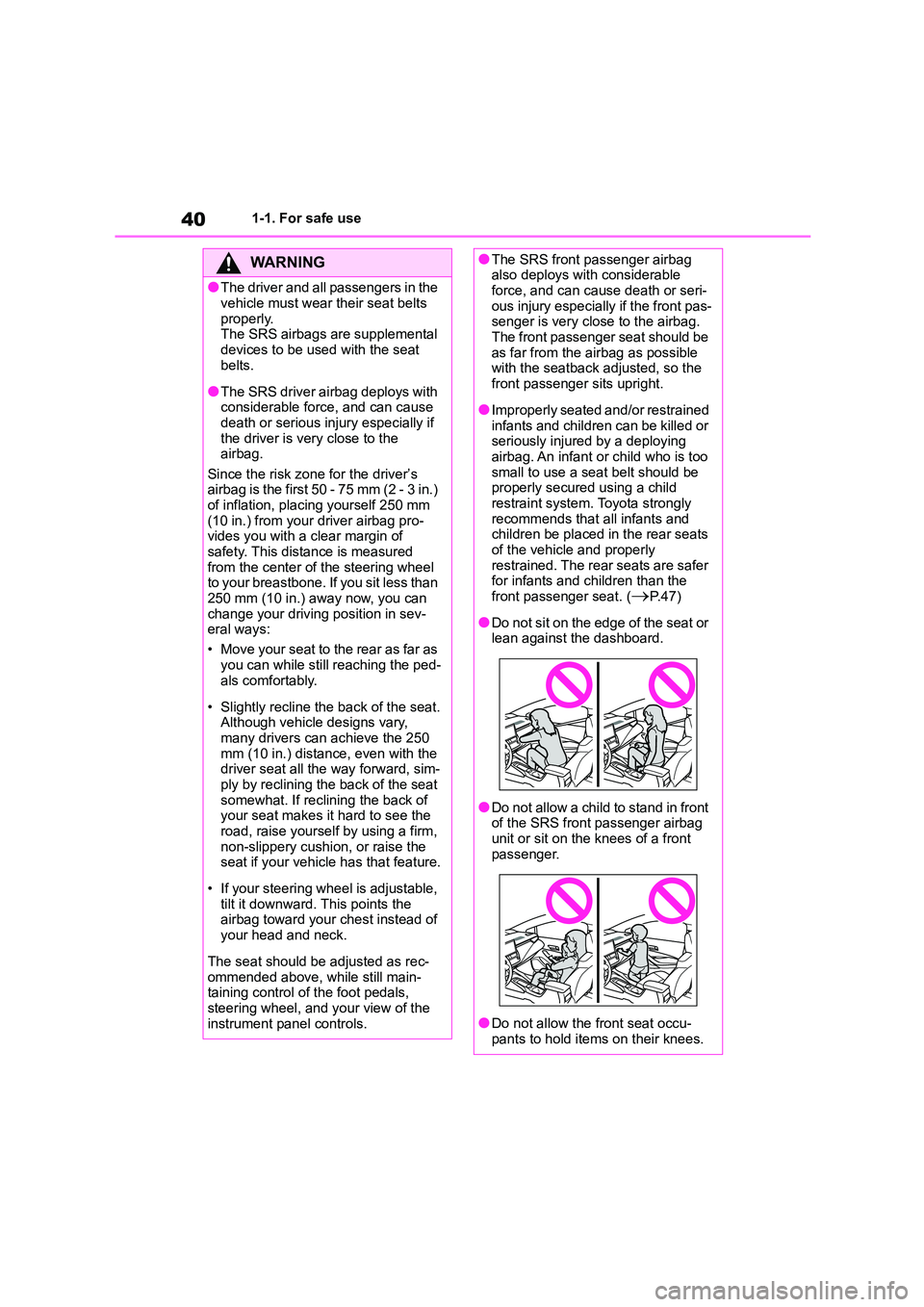
401-1. For safe use
WA R N I N G
●The driver and all passengers in the
vehicle must wear their seat belts
properly. The SRS airbags are supplemental
devices to be used with the seat
belts.
●The SRS driver airbag deploys with
considerable force, and can cause
death or serious injury especially if the driver is very close to the
airbag.
Since the risk zone for the driver’s airbag is the first 50 - 75 mm (2 - 3 in.)
of inflation, placing yourself 250 mm
(10 in.) from your driver airbag pro- vides you with a clear margin of
safety. This distance is measured
from the center of the steering wheel to your breastbone. If you sit less than
250 mm (10 in.) away now, you can
change your driving position in sev- eral ways:
• Move your seat to the rear as far as
you can while still reaching the ped- als comfortably.
• Slightly recline the back of the seat. Although vehicle designs vary,
many drivers can achieve the 250
mm (10 in.) distance, even with the driver seat all the way forward, sim-
ply by reclining the back of the seat
somewhat. If reclining the back of your seat makes it hard to see the
road, raise yourself by using a firm,
non-slippery cushion, or raise the seat if your vehicle has that feature.
• If your steering wheel is adjustable, tilt it downward. This points the
airbag toward your chest instead of
your head and neck.
The seat should be adjusted as rec-
ommended above, while still main- taining control of the foot pedals,
steering wheel, and your view of the
instrument panel controls.
●The SRS front passenger airbag also deploys with considerable
force, and can cause death or seri-
ous injury especially if the front pas- senger is very close to the airbag.
The front passenger seat should be
as far from the airbag as possible with the seatback adjusted, so the
front passenger sits upright.
●Improperly seated and/or restrained
infants and children can be killed or
seriously injured by a deploying airbag. An infant or child who is too
small to use a seat belt should be
properly secured using a child restraint system. Toyota strongly
recommends that all infants and
children be placed in the rear seats of the vehicle and properly
restrained. The rear seats are safer
for infants and children than the front passenger seat. (P. 4 7 )
●Do not sit on the edge of the seat or lean against the dashboard.
●Do not allow a child to stand in front of the SRS front passenger airbag
unit or sit on the knees of a front
passenger.
●Do not allow the front seat occu-
pants to hold items on their knees.